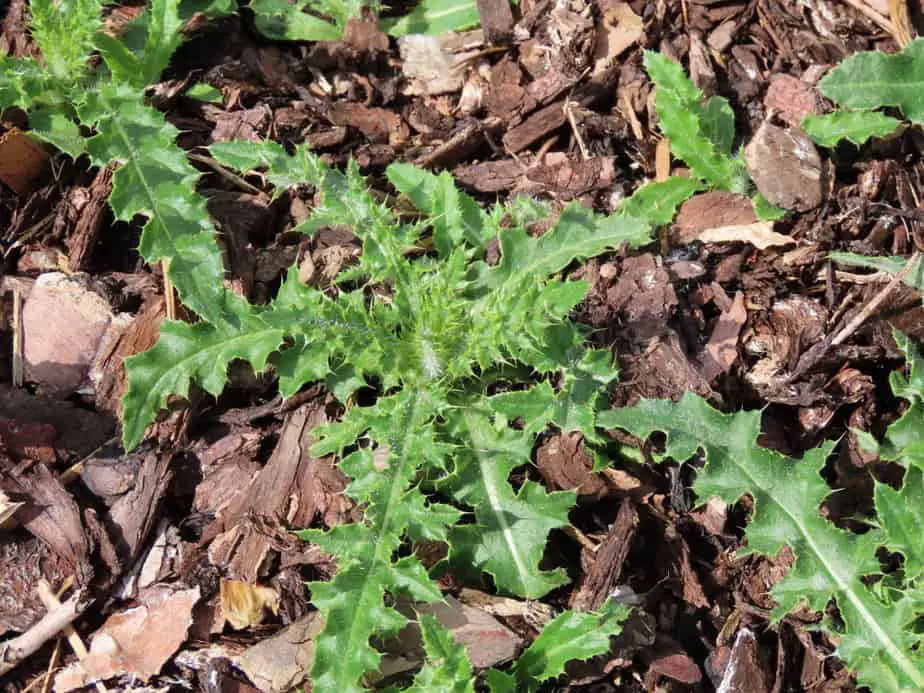No one likes unsightly weeds in their garden, and they are not good for the health of your plants, flowers, or lawn either. They can grow very quickly, though, and pulling out weeds can become an ongoing chore. Using mulch in your garden can be a great way to control your weeds, but what do you do if your weeds continue to grow in the mulch anyway? Here we give you some tips on how to keep weeds out of your mulch.

Table of Contents
Why You Should Use Mulch
Adding a layer of mulch keeps your soil cool and moist in summer, and in winter, it acts like a blanket protecting your plants from frost. The mulch also stops the sun from drying your soil out. This also means you will need to spend less time watering your plants. When mulch breaks down, it adds nutrients to your soil, which makes your garden healthier. Mulch can also be an attractive addition to your garden.
One of the common reasons people add mulch to their garden, though, is because it can reduce weed growth. It does this by creating a barrier that stops new weed seeds from taking root in the soil. The mulch also blocks the sun, so seeds that are already in the soil won’t grow, but will lie dormant.
How To Stop Weeds Growing In Mulch
If you are a keen gardener, as soon as you see a weed growing in your mulch, you are likely to pull it out by hand. But what else can you do to help stop weeds growing in your mulch?
Use Pre-emergent Herbicides
Using a pre-emergent herbicide along with your mulch, is a great way to prevent weeds. But as the name suggests, this needs to be done before the weed sprouts otherwise, it won’t achieve anything. The pre-emergent herbicide will stop annual weeds from germinating, but it doesn’t help with all weeds, for example, perennial weeds.
You can buy pre-emergent herbicides from garden supply stores. Liquid herbicides are more effective as they stick to the mulch rather than falling to the ground. You will need to follow the product instructions very carefully, and make sure it is suitable for the plants you are growing. The process usually needs to be repeated every 5 to 6 months.
Put A Weed Barrier In Place
Another way to stop weeds growing in your mulch is to use a black plastic weed barrier beneath your mulch layer. The plastic needs to be black, not clear, to help stop the sunlight from coming through. Before you put the barrier down, you need to pull out any weeds that are already growing, and then use a trowel to remove any remaining roots. You then spread the weed barrier over the entire area you intend to put the mulch on.
You’ll need to cut holes in the plastic to fit over any existing plants and make holes for where you intend to plant any new plants. You then add around a three-inch layer of mulch over the barrier so that no plastic is showing. I wouldn’t recommend using a plastic barrier if you are planning to plant trees or shrubs, as the plastic can stop the roots from getting the water they need to grow properly.
If you are not keen on using plastic, there are also landscape fabric barriers which can last up to five years, depending on the type of landscape fabric you use. An even more environmentally friendly alternative is to use newspapers for the barrier instead, although as the newspaper is biodegradable, you will need to replace it more often.
- Dewitt weed barrier 12-years is an easy-to-use, environmentally safe fabric that controls weeds before they start
- The non-woven, hydro philic treated fabric allows air and water to pass through
- Dewitt landscape fabric minimizes light penetration to suppress weed growth
- Fabric is treated to minimize degradation due to UV light exposure
- The design also prevents unraveling and makes the material easier to cut; Measures 4 by 50 feet
Last update on 2025-03-28 / Affiliate links / Images from Amazon Product Advertising API
Use High-Quality Mulch
If you use high-quality mulch made out of wood chips, bark, or sawdust, it will need replacing less often. Using grass clippings, shredded leaves, or straw creates a much lower quality mulch, which can be less effective. You do need to keep in mind what plants you are planning to grow, though, as this will impact the best type of mulch to use.
Keep Replenishing Your Mulch
Your mulch gets blown away and decomposes over time, so you need to replenish it regularly. Mulch blocks out the sun, which helps prevent leaves, so if your layer of mulch becomes too thin, it won’t be able to do this properly. It usually needs to be replaced at least yearly. It’s best not to have your mulch more than about 3 inches thick, as too much can smoother the base of the plant, and deprive your soil of oxygen.
Final Thoughts
Although you will never stop weeds from growing in your mulch completely, following these tips should help you make your garden beautiful and weed-free.
